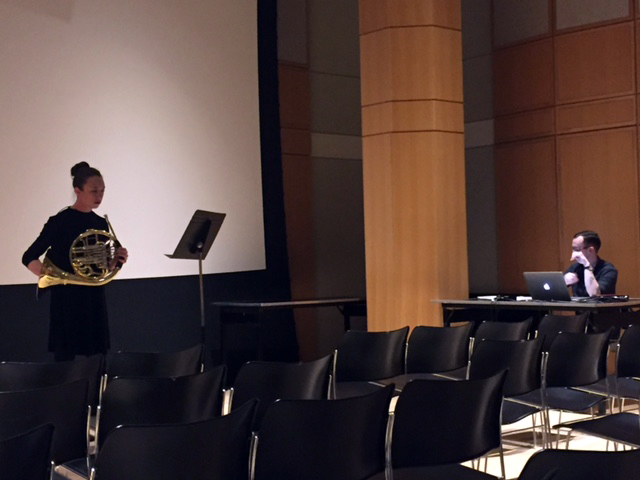
This year’s English Student Association Graduate Student Conference, “The Vibrating World: Soundscapes and Undersongs” centered around the interdisciplinary field of Sound Studies, which explores ideas of music, voice, noise, silence, and vibration in relation to politics, space, and corporeality.
The morning session included the panel “Sonic Warfare” named after Steve Goodman’s foundational text Sonic Warfare: Sound, Affect, and the Ecology of Fear. The panel included two graduate students in English at the GC who presented work developed in Eric Lott’s Spring 2015 “Ontologies of Vibration” course. Sarah Hildebrand (GC English) explored the detrimental effects of anthropogenic sound on natural environments, while Mikey Rumore (GC English) theorized tinnitus to explore a politics of sounds and affects that go unrecorded or masked. Nicholas Glastonbury (GC Anthropology) focused on shifts in Turkish and Kurdish language to signify conflict in the film Jîn (2013), while Amy Emery Kraizman (GC MALS) explored the role of music to represent the psychological effects of war in the Russian film Two Soldiers (1943).
In the afternoon session “Sonic and Textual Archives,” participants delved into the sonic materiality of the archive, particularly the PennSound audio recording archive. Mary Catherine Kinniburgh (GC English) challenged the dominance of text in archives by exploring how audio archives can reveal a network and community, while Zack Brown (English, University at Buffalo) used Object Oriented Ontology to theorize the secret lives of objects. Cherrie Kwok (English, NYU) discussed the practice of “close listening” with a recording of Charles Olson reading his famous poem “The Kingfishers.” Aidan Levy (English, Columbia University) turned to the role of jazz across media to theorize communal response in Rudolph Fisher’s short story “Common Meter” and Bessie Smith’s performance in the film St. Louis Blues (1929).
Meanwhile, in the Segal Theatre, Elizabeth Fleming Martignetti (GC Musicology) and Andrew Noseworthy (Music Theory and Composition, NYU Steinhardt) performed their collaborative work “Somewhat Speak.” Martignetti performed on a French horn with modified valves, adding striking vocal and visual gestures to her performance while Noseworthy’s tape contributed distortions of Martignetti’s utterances. Afterward, participants discussed ways in which the sounds of the ‘disabled’ horn and the tape’s interference deconstructed and interrogated conventional approaches to the horn’s instrumental vocality as well as the concept of classically ‘perfect’ or ‘whole’ musical sound.
Joseph Straus, Distinguished Professor of Music at the GC, delivered the evening keynote. Speaking on material from his recently completed book, Straus introduced the concept of a “disability aesthetics” underpinning musical modernism. With animated graphic annotations of musical scores and analytic narration to help guide the interdisciplinary audience through examples from Debussy, Satie, Stravinsky, Ives, Schoenberg, Thomson, Webern, and Babbitt, Straus drew connections between specific conditions of disability and distinct qualities of modernist music. Concluding that “the modern in music manifests itself as disability,” Straus argued that modernist music both reflects intolerant eugenic attitudes toward the features of disability to which it gives aesthetic form and “affirmatively claims disability as a valuable artistic resource.”
The conference concluded with a special performance by artist Gill Arno. In his project,mpld, Arno improvises using modified slide projectors which are connected by feedback loops to pulsating lights, found slide images, and internal microphones. Following his performance, audience members were able to see his modified projectors up close and discussed the ways in which sound, light, and image interacted in their experience. For some, natural images coincided with aural pulsations to evoke the sense of an environment under threat.